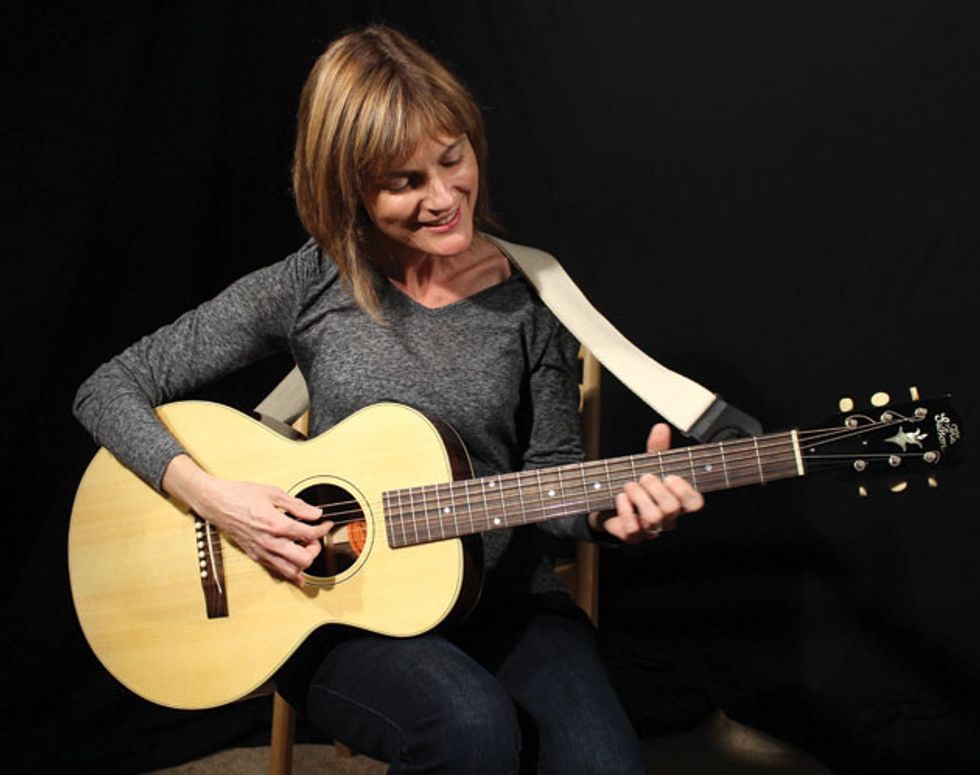Like many other guitarists who are perceived as being serious about their instrument, I’m often asked to recommend makes and models. I’m happy to offer suggestions, but I recently had an experience that reminded me how important it is to keep an open mind when shopping for an acoustic guitar.
A friend of mine—Bay Area singer-songwriter Marla Van Hoose Beck—was ready for a new flattop. She had taken a break from performing when her daughter was born six years ago, and she wanted something more inspiring and stageworthy than the entry-level axe she’d been playing. I started by asking Marla to think about the same questions I always pose when someone wants to upgrade their instrument: What don’t you like about your current guitar? What features do you definitely want to have on your new guitar? Where will you play the new guitar? How much money can you spend?
Determining what you don’t like about the guitar you already have is an important step. It’s hard to define “better” when you’re not sure what you’d like to improve on. In Marla’s case, she felt that her old guitar was hard to play. She said she wanted her new guitar to have a pickup so she could plug in at the local open mic, and she liked the idea of a cutaway. Getting a new guitar was also going to be a bit of a mid-life reward to herself.
Marla had already tried a Taylor 314, was wowed by its playability, and was basically ready to just go out and buy one. So accordingly, our first stop was the nearest Taylor dealer, Bananas at Large in San Rafael, California. One of their sales guys, Rik Elswit, is a friend of mine, so we made sure he’d be there.
Here’s a tip: If you already have a connection with someone at a store, try to go during their shift since it will most likely make for a more comfortable shopping experience. Rik set out a selection of Taylors for Marla and she played them all. There were some really nice guitars in the bunch, but for one reason or another, none of them spoke to her the way she thought they would.
Though this discovery led to some disappointment, it also meant that the door was suddenly wide open to other possibilities, at least within the primary parameters of a small-bodied guitar. Marla was pretty sure she preferred a shorter scale after playing both long-scale and short-scale instruments, so that helped us refine the search. We also discussed different wood options, but agreed that physical fit was going to be the first criterion.
Much to my surprise, Marla’s favorite guitar that day was a Martin 00-28VS. It’s indeed a great instrument, but with its 12-fret design, slotted headstock, and wide neck, it was about as removed from the Taylors she’d expressed interest in as you can get. The guitar was also almost twice as much as her original budget allowed.
Over the next couple of weeks, Marla played a lot of guitars. She ultimately became interested in Gibsons after playing an LG-2 at Schoenberg Guitars in Tiburon, California, where we went with the intention of looking at more Martins. They had a Martin 00-18V that I thought would be the perfect guitar for Marla, but she didn’t care for it. And this is where I had to adjust what I thought would be the right guitar for her.
You see, while I hear small-body Gibson acoustics sounding great in the hands of other players all the time, the sound just doesn’t tend to work so well for the contemporary fingerstyle I mostly play. And I tend to think of these guitars as being ideal for fingerpicking the blues, not necessarily a singer-songwriter who plays with a fairly light touch.
A week later, Marla called. She’d found her dream guitar at Tall Toad Music in Petaluma, California, a shop I actually used to work at. The guitar turned out to be a limited edition Gibson L-2 Blues Tribute, which is a 14-fret small-body guitar with an Adirondack spruce top and Indian rosewood back and sides. Even though it’s completely different from what Marla thought she wanted—it has a chunky neck, a much rougher, midrangey voice, no cutaway, no electronics (adding those will be our next project), and a considerably higher price, it really suits her well—both in terms of being a great fit for her size and being a great match for accompanying her vocals.
Allowing herself to look past what she thought she wanted was a very important first step for Marla. To develop a clear picture of what she wanted to hear and how the guitar should feel, she asked lots of questions in the shopping process, and the answers she found helped her communicate with the sales people at the various shops. Even though she’d set a budget, she allowed herself to make an adjustment once she realized the guitars she really liked cost a bit more. If spending more money had been out of the question, we would have devoted more time to hone in on other options within her original range.
Marla had few preconceived notions about who typically played the models she was looking at, and this actually turned out to be an advantage. With some guidance she was able to choose the guitar that was right for her.









![Rig Rundown: Russian Circles’ Mike Sullivan [2025]](https://www.premierguitar.com/media-library/youtube.jpg?id=62303631&width=1245&height=700&quality=70&coordinates=0%2C0%2C0%2C0)








